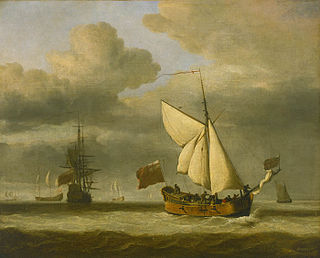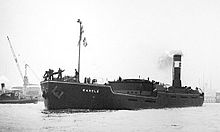
Wandsworth Town is a district of south London, within the London Borough of Wandsworth 4.2 miles (6.8 km) southwest of Charing Cross. The area is identified in the London Plan as one of 35 major centres in Greater London.

Battersea Power Station is a decommissioned Grade II* listed coal-fired power station, located on the south bank of the River Thames, in Nine Elms, Battersea, in the London Borough of Wandsworth. It was built by the London Power Company (LPC) to the design of Leonard Pearce, Engineer in Chief to the LPC, and CS Allott & Son Engineers. The architects were J. Theo Halliday and Giles Gilbert Scott. The station is one of the world's largest brick buildings and notable for its original, Art Deco interior fittings and decor.
The Port of London is that part of the River Thames in England lying between Teddington Lock and the defined boundary with the North Sea and including any associated docks. Once the largest port in the world, it was the United Kingdom's largest port as of 2020. Usage is largely governed by the Port of London Authority ("PLA"), a public trust established in 1908; while mainly responsible for coordination and enforcement of activities it also has some minor operations of its own.

Bankside Power Station is a decommissioned electricity generating station located on the south bank of the River Thames, in the Bankside area of the Borough of Southwark, London. It generated electricity from 1891 to 1981. It was also used as a training base for electrical and mechanical student apprenticeships from all over the country. Since 2000 the building has been used to house the Tate Modern art museum and gallery.

Nine Elms is an area of south-west London, England, within the London Borough of Wandsworth. It lies on the River Thames, with Battersea to the west, South Lambeth to the south and Vauxhall to the east.
The utility infrastructure of London, England comprises a range of services and facilities that support and enable the functioning of London as a world city. Infrastructure includes facilities associated with products and materials that are consumed such as electricity, gas, water, heating and liquid fuels; materials that are produced such as sewage and solid waste; and facilities that enable communication and connectivity – telecommunications.

Cory is a recycling and waste management company based in London. Originally founded as William Cory & Son in 1896, the company has operated vessels on the River Thames for more than 125 years, transporting a range of commodities and materials including coal, oil, aggregates and waste. Ships from Cory's fleet supported Britain's war efforts in both world wars, with 30 ships being lost during the conflicts. From the 1980s onwards, the business has become increasingly focused on waste management.

Hall, Russell & Company, Limited was a shipbuilder based in Aberdeen, Scotland.

The Gas Light and Coke Company, was a company that made and supplied coal gas and coke. The headquarters of the company were located on Horseferry Road in Westminster, London. It is identified as the original company from which British Gas plc is descended.

A collier is a bulk cargo ship designed or used to carry coal. Early evidence of coal being transported by sea includes use of coal in London in 1306. In the fourteenth and fifteenth centuries, coal was shipped from the River Tyne to London and other destinations. Other ports also exported coal – for instance the Old Quay in Whitehaven harbour was built in 1634 for the loading of coal. London became highly reliant on the delivery of coal by sea – Samuel Pepys expressed concern in the winter of 1666–67 that war with the Dutch would prevent a fleet of 200 colliers getting through. In 1795, 4,395 cargoes of coal were delivered to London. By 1824, this number had risen to about 7,000; by 1839, it was over 9,000. The trade continued to the end of the twentieth century, with the last cargo of coal leaving the Port of Tyne in February, 2021.

Brimsdown Power Station was a coal-fired power station on the Lee Navigation at Brimsdown in Middlesex. The station had seven cooling towers which were visible from a wide area.
Fulham Power Station was a coal-fired power station on the north bank of the River Thames at Battersea Reach in Fulham, London

Three distinct coal-fired power stations were built at Deptford on the south bank of the River Thames, the first of which is regarded as the first central high-voltage power station in the world.
Stephenson Clarke Shipping Limited, established in 1730 was Great Britain's oldest shipping company. The company specialized in short sea bulk cargo such as aggregates, alumina, grain, coal, fertilizers and steel.
USNS Antioch (T-AG-180) was the United States Navy name assigned to the United States Merchant Marine Victory Ship SS Alfred Victory. She was built in 1945 and had a tonnage of 7,607 GRT.

The Burntisland Shipbuilding Company was a shipbuilder and repairer in Burntisland, Fife, Scotland that was founded in 1918. In 1969 it was taken over by Robb-Caledon Shipbuilders, which in turn was nationalised in 1977 as part of British Shipbuilders.

The London Power Company was an electricity generating and bulk supply company in London, England, formed in 1925 by the merger of ten small electricity companies. In 1948 Britain's electricity supply industry was nationalised under the Electricity Act 1947 and the company was absorbed into the British Electricity Authority.
The Wandsworth and District Gas Company was a maker and distributor of coal gas in southwest London from 1834 until 1949.

SS Wandle was a British coastal collier owned and operated by the proprietors of Wandsworth gas works in south-west London. She was a flatiron, meaning that she had a low-profile superstructure, hinged funnel, hinged or telescopic mast and folding wheelhouse to enable her to pass under low bridges on the tidal River Thames upriver from the Pool of London. She was in service from 1932 to 1959 and survived a number of enemy attacks in the Second World War.
SS Gasfire was a British steam collier of the Gas Light and Coke Company (GLCC). She was built in Sunderland in 1936, survived severe damage from being torpedoed in 1940 and was sunk by a mine in the North Sea in 1941.

















